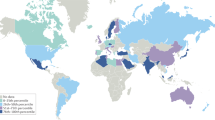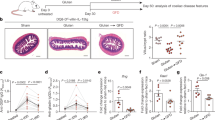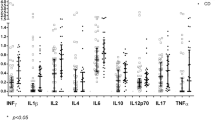Abstract
Two common chronic childhood diseases—celiac disease (CD) and type 1 diabetes (T1D)—result from complex pathological mechanisms where genetic susceptibility, environmental exposure, alterations in intestinal permeability and immune responses play central roles. In this study, we investigated whether these characteristics were universal for CD independently of T1D association. For this purpose, we studied 36 children with normal small-bowel mucosa and 26 children with active CD, including 12 patients with T1D. In samples from the small-bowel mucosa, we detected the lowest expression of tight junction protein 1 (TJP1) mRNA in CD patients with T1D, indicating an increase in intestinal permeability. Furthermore, these samples displayed the highest expression of forkhead box P3 (FoxP3) mRNA, a marker for regulatory T cells, as compared with other patient groups. At the same time, serum levels of IgA antibodies specific for the CD-related antigens deamidated gliadin and tissue transglutaminase (tTG) were the highest in CD patients with T1D. In contrast, no significant differences were found in IgA or IgG antibodies specific for bovine beta-lactoglobulin or Bifidobacterium adolescentis DSM 20083-derived proteins. There were also no differences in the transamidating activity of serum autoantibodies between patients and control individuals. Our results show that patients with T1D and newly detected CD exhibit severely altered intestinal permeability, strong local immune activation and increased immunoregulatory mechanisms in the small bowel. Further study is required to determine whether these extreme changes in this CD subgroup are due to some specific environmental factors (virus infections), unknown genetic effects or autoimmune reactions to antigenic targets in intracellular tight junctions.
This is a preview of subscription content, access via your institution
Access options
Subscribe to this journal
Receive 12 digital issues and online access to articles
$119.00 per year
only $9.92 per issue
Buy this article
- Purchase on Springer Link
- Instant access to full article PDF
Prices may be subject to local taxes which are calculated during checkout



Similar content being viewed by others
References
Green PH, Cellier C . Celiac disease. N Engl J Med 2007; 357: 1731–1743.
Franzese A, Lombardi F, Valerio G, Spagnuolo A . Update on coeliac disease and type 1 diabetes mellitus in children. J Ped Endocrinol Metab 2007; 20: 1257–1264.
Smyth DJ, Plagnol V, Walker NM, Cooper JD, Downes K, Yang JH et al. Shared and distinct genetic variants in type 1 diabetes and celiac disease. N Engl J Med 2008; 359: 2767–2777.
Visser J, Rozing J, Sapone A, Lammers K, Fasano A . Tight junctions, intestinal permeability, and autoimmunity. Celiac disease and type 1 diabetes paradigms. Ann NY Acad Sci 2009; 1165: 195–205.
Lefebvre DE, Powell KC, Strom A, Scott FW . Dietary proteins as environmental modifiers of type 1 diabetes mellitus. Ann Rev Nutr 2006; 26: 175–202.
Catassi C, Kryszak D, Bhatti B, Sturgeon C, Helzlsouer K, Clipp SL et al. Natural history of celiac disease autoimmunity in a USA cohort followed since 1974. Ann Med 2010; 42: 530–538.
Borchers AT, Uibo R, Gershwin ME . The geoepidemiology of type 1 diabetes. Autoimmun Rev 2010; 9: A355–A365.
Kondrashova A, Mustalahti K, Kaukinen K, Viskari H, Volodicheva V, Haapala AM et al. Lower economic status and inferior hygiene environment may protect against celiac disease. Ann Med 2008; 40: 223–231.
Ress K, Harro M, Maaroos HI, Harro J, Uibo R, Uibo O . High prevalence of celiac disease: need for increasing awareness among physicians. Dig Liv Dis 2007; 39: 136–139.
Jabri B, Sollid LM . Tissue-mediated control of immunopathology in coeliac disease. Nat Rev Immunol 2009; 9: 858–870.
Lewis NR, Scott BB . Meta-analysis: deamidated gliadin peptide antibody and tissue transglutaminase antibody compared as screening tests for coeliac disease. Aliment Pharmacol Ther 2010; 31: 73–81.
Marsh MN, Crowe PT . Morphology of the mucosal lesion in gluten sensitivity. Bailleres Clin Gastroenterol 1995; 9: 273–293.
Tiittanen M, Westerholm-Ormio M, Verkasalo M, Savilahti E, Vaarala O . Infiltration of forkhead box P3-expressing cells in small intestinal mucosa in coeliac disease but not in type 1 diabetes. Clin Exp Immunol 2008; 152: 498–507.
Vorobjova T, Uibo O, Heilman K, Rägo T, Honkanen J, Vaarala O et al. Increased FOXP3 expression in small-bowel mucosa of children with coeliac disease and type 1 diabetes mellitus. Scand J Gastroenterol 2009; 44: 422–430.
Westerholm-Ormio M, Vaarala O, Tittanen M, Savilahti E . Infiltration of Foxp3- and Toll-like receptor-4-positive cells in the intestines of children with food allergy. J Pediatr Gastroenterol Nutr 2010; 50: 367–376.
Skovbjerg H, Hansen GH, Niels-Christiansen LL, Anthonsen D, Ascher H, Midhagen G et al. Intestinal tissue transglutaminase in coeliac disease of children and adults: ultrastructural localization and variation in expression. Scand J Gastroenterol 2004; 39: 1219–1227.
Pinkas DM . Strop P, Brunger AT, Khosla C . Transglutaminase 2 undergoes a large conformational change upon activation. PloS Biol 2007; 5: e327.
Sartor RB . Microbial influences in inflammatory bowel disease. Gastroenterology 2008; 134: 577–594.
Ménard S, Cerf-Bensussan N, Heyman M . Multiple facets of intestinal permeability and epithelial handling of dietary antigens. Mucosal Immunol 2010; 3: 247–259.
Lammers KM, Lu R, Brownley J, Lu B, Gerard C, Thomas K et al. Gliadin induces an increase in intestinal permeability and zonulin release by binding to the chemokine receptor CXCR3. Gastroenterology 2008; 135: 194–204.
Schulzke JD, Bentzel CJ, Schulzke I, Riecken EO, Fromm M . Epithelial tight junction structure in the jejunum of children with acute and treated celiac sprue. Pediatr Res 1998; 43: 435–441.
Secondulfo M, Iafusco D, Carratù R, deMagistris L, Sapone A, Generoso M et al. Ultrastructural mucosal alterations and increased intestinal permeability in non-coeliac, type 1 diabetic patients. Dig Liv Dis 2004; 36: 35–45.
Bosi E, Molteni L, Radaelli MG, Folini L, Fermo L, Bazzigaluppi E et al. Increased intestinal permeability preceded clinical onset of type 1 diabetes. Diabetologia 2006; 49: 2824–2827.
Sapone A, de Magistris L, Pietzak M, Clemente MG, Tripathi A, Cucca F et al. Zonulin upregulation is associated with increased gut permeability in subjects with type 1 diabetes and their relatives. Diabetes 2006; 55: 1443–1449.
Neu J, Reverte M, Mackey AD, Liboni K, Tuhacek-Tenace LM, Hatch M et al. Changes in intestinal morphology and permeability in the biobreeding rat before the onset of type 1 diabetes. J Pediatr Gastroenterol Nutr 2005; 40: 589–595.
Watts T, Berti I, Sapone A, Gerarduzzi T, Not T, Zielke R et al. Role of the intestinal tight junction modulator zonulin in the pathogenesis of type 1 diabetes in BB diabetic-prone rats. Proc Natl Acad Sci USA 2005; 102: 2916–2921.
Lee AS, Gibson DL, Zhang Y, Sham HP, Vallance BA, Dutz JP . Gut barrier disruption by an enteric bacterial pathogen accelerates insulitis in NOD mice. Diabetologia 2010; 53: 741–748.
Ou G, Hedberg M, Hörstedt P, Baranov V, Forsberg G, Drobni M et al. Proximal small intestinal microbiota and identification of rod-shaped bacteria associated with childhood celiac disease. Am J Gastroenterol 2009; 104: 3058–3067.
Prangli AL, Utt M, Talja I, Sepp E, Mikelsaar M, Rajasalu T et al. An immunoblot assay for determination of IgG antibodies against lactobacilli representing human indigenous microflora. Pediatr Allergy Immunol 2010; 21: e772–e779.
Giongo A, Gano KA, Crabb DB, Mukherjee N, Novelo LL, Casella G et al. Toward defining the autoimmune microbiome for type 1 diabetes. ISME J 2010; 5: 82–91.
Young SL, Simon MA, Baird MA, Tannock GW, Bibiloni R, Spencely K et al. Bifidobacterial species differentially affect expression of cell surface markers and cytokines of dendritic cells harvested from cord blood. Clin Diagn Lab Immunol 2004; 11: 686–690.
He F, Ouwehand AC, Isolauri E, Hashimoto H, Benno Y, Salminen S . Comparison of mucosal adhesion and species identification of bifidobacteria isolated from healthy and allergic infants. FEMS Immunol Med Microbiol 2001; 30: 43–47.
Stsepetova J, Sepp E, Julge K, Vaughan E, Mikelsaar M, de Vos WM . Molecularly assessed shifts of Bifidobacterium spp. and less diverse microbial communities are characteristic of 5-year-old allergic children. FEMS Immunol Med Microbiol 2007; 51: 260–269.
Vaarala O, Atkinson M, Neu J . The “perfect storm” for type 1 diabetes. The complex interplay between intestinal microbiota, gut permeability, and mucosal immunity. Diabetes 2008; 10: 2555–2562.
Arrieta MC, Bistritz L, Meddings JB . Alterations in intestinal permeability. Gut 2006; 55: 1512–1520.
Uibo O, Heilman K, Rägo T, Shor R, Paal M, Metsküla K et al. Symptomless coeliac disease in type I diabetes: 12-year experience in Estonia. Pediatr Int 2010; 52: 230–233.
Marsh MN . Gluten, major histocompatibility complex, and the small intestine: a molecular and immunobiologic approach to the spectrum of gluten sensitivity (“celiac sprue”). Gastroenterology 1992; 102: 330–354.
Green PH, Rostami K, Marsh MN . Diagnosis of coeliac disease. Best Pract Res Clin Gastroenterol 2005; 19: 389–400.
Walker-Smith J, Guandalini S, Schmitz J, Shmerling DH, Visakorpi JK . Revised criteria for diagnosis of celiac disease. Report of working group of European Society of Pediatric Gastroenterology and Nutrition. Arch Dis Child 1990; 65: 909–911.
Teesalu K, Agardh D, Panarina M, Utt M, Uibo O, Uibo R . A modified ELISA for improved detection of IgA, IgG, IgM anti-tissue transglutaminase antibodies in celiac disease. Clin Chim Acta 2009; 403: 37–41.
Nilsson I, Kornilovs'ka I, Lindgren S, Ljungh A, Wadström T . Increased prevalence of seropositivity for non-gastric Helicobacter species in patients with autoimmune liver disease. J Med Microbiol 2003: 52: 949–953.
Király R, Vecsei Z, Deményi T, Korponay-Szabó IR, Fésüs L . Coeliac autoantibodies can enhance transamidating and inhibit GTPase activity of tissue transglutaminase: dependence on reaction environment and enzyme fitness. J Autoimmun 2006; 26: 278–287.
Sambuy Y, de Angelis I, Ranaldi G, Scarino ML, Stammati A, Zucco F . The Caco-2 cell line as a model of the intestinal barrier: influence of cell and culture-related factors on Caco-2 cell functional characteristics. Cell Biol Toxicol 2005; 21: 1–26.
Cronin CC, Shanafan F . Insulin-dependent diabetes mellitus and coeliac disease. Lancet 1997; 349: 1096–1097.
Barera G, Bonfanti R, Viscardi M, Bazzigaluppi E, Calori G, Meschi F et al. Occurrence of celiac disease after onset of type 1 diabetes: a 6-year prospective longitudinal study. Pediatrics 2002; 109: 833–838.
Guttman JA, Finlay BB . Tight junctions as targets of infectious agents. Biochim Biophys Acta 2009; 1788: 832–841.
Laparra JM, Sanz Y . Bifidobacteria inhibit the inflammatory response induced by gliadins in intestinal epithelial cells via modifications of toxic peptide generation during digestion. J Cell Biochem 2010; 109: 801–807.
Barnes RM, Harvey MM, Blears J, Finn R, Johnson PM . IgG subclass of human serum antibodies reactive with dietary proteins. Int Arch Allergy Appl Immunol 1986; 81: 141–147.
Savilahti E, Saukkonen TT, Virtala ET, Tuomilehto J, Kerblom HK . The Childhood Diabetes in Finland Study Group. Increased levels of cow's milk and β-lactoglobulin antibodies in young children with newly diagnosed IDDM. Diabetes Care 1993; 16: 984–989.
Simpson M, Mojibian M, Barriga K, Scott FW, Fasano A, Rewers M et al. An exploration of Glo-3A antibody levels in children at increased risk for type 1 diabetes mellitus. Pediatr Diabetes 2009; 10: 563–572.
Fasano A, Not T, Wang W, Uzzau S, Berti I, Tommasini A et al. Zonulin, a newly discovered modulator of intestinal permeability, and its expression in coeliac disease. Lancet 2000; 355: 1518–1519.
Acknowledgements
This work was supported by grants 7749 and 8334 from the Estonian Science Foundation and by the European Union through the European Regional Development Fund and FP. The help of Mrs Tiina Rägo, MD, Mrs Anu Kaldmaa, Ms Kadri Eomäe, and Mrs Anu Kõiveer in the preparation of clinical material, cell culture and the performance of antibody assays is greatly appreciated. We also thank our colleagues from Finland, Professor Jorma Ilonen from Turku University, Professor Outi Vaarala from the National Institute for Health and Welfare and Professor Erkki Savilahti from the Children's Hospital, University of Helsinki, for their support.
Author information
Authors and Affiliations
Rights and permissions
About this article
Cite this article
Uibo, R., Panarina, M., Teesalu, K. et al. Celiac disease in patients with type 1 diabetes: a condition with distinct changes in intestinal immunity?. Cell Mol Immunol 8, 150–156 (2011). https://doi.org/10.1038/cmi.2010.66
Received:
Accepted:
Published:
Issue Date:
DOI: https://doi.org/10.1038/cmi.2010.66
Keywords
This article is cited by
-
Circulating Zonulin Correlates with Density of Enteroviruses and Tolerogenic Dendritic Cells in the Small Bowel Mucosa of Celiac Disease Patients
Digestive Diseases and Sciences (2017)
-
Autoantibodies from patients with celiac disease inhibit transglutaminase 2 binding to heparin/heparan sulfate and interfere with intestinal epithelial cell adhesion
Amino Acids (2012)



